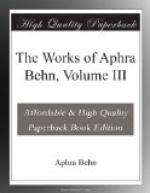p. 305 The Representation of the Wedding. This curious tableau is a striking example of the Elizabethan ‘Dumb Show’ lingering on to Restoration days. Somewhat similar, though by no means such complete, examples may be seen in Orrery’s Henry the Fifth (1664), at the commencement of Act iv, and again in the same author’s The Black Prince (19 October, 1667), Act ii. It must be confessed that Mrs. Behn has made an excellent use of this technical contrivance. In the Restoration theatre it was the usual practice for the curtain to rise at the beginning and fall at the end of the play, so that the close of each intermediate act was only shown by a clear stage. Although I have marked Act ii, sc. I of The Forc’d Marriage ‘The Palace’, I have little doubt that as the drama was staged Smith and Mrs. Jennings advanced and the curtain fell behind them hiding the rest of the characters, only to rise again upon Scene II, ‘The Court Gallery’. Philander and Galatea played upon the apron stage. If they, however, maintained their places in the tableau, they would have immediately after entered on to the apron, before the curtain, by way of the proscenium doors. In any case Scene I must have been acted well forward.
p. 312 rencounter. Meet.
p. 322 Phi. Who’s there. The Duke of Buckingham, in The Rehearsal (1671), Actus ii, scaena V, has a fray burlesquing this passage.
p. 325 Phi. Villain, thou ly’st. cf. The Rehearsal, Actus v, scaena I: ’Lieutenant-General. Villain, thou lyest.’
p. 330 Campania. The operations of an army in the field during a season. cf. Edmund Everard’s Discourses on the Present State of the Protestant Princes of Europe (1679): ’Since the last campania the Three ... have entred into the entanglement of a War.’
p. 331 Pattacoon. A Spanish dollar value 4s. 8d; vide supra, Vol. I, The Rover (I), ii, I (p. 36) and note on that passage, p. 442.
p. 347 in a dishabit. This word is excessively rare, if this be not the unique example. The N.E.D. fails to include it. Dishabille had been introduced from France in the reign of Charles II, and (in its various forms) became exceedingly popular. It is noticeable that all other editions, save the first quarto (1671), in this passage read ‘in an undress’.
p. 352 or smothers her with a pillow. This is only in the first quarto. Here in particular, and throughout the whole scene, Mrs. Behn’s reminiscences of Othello are very patent.




